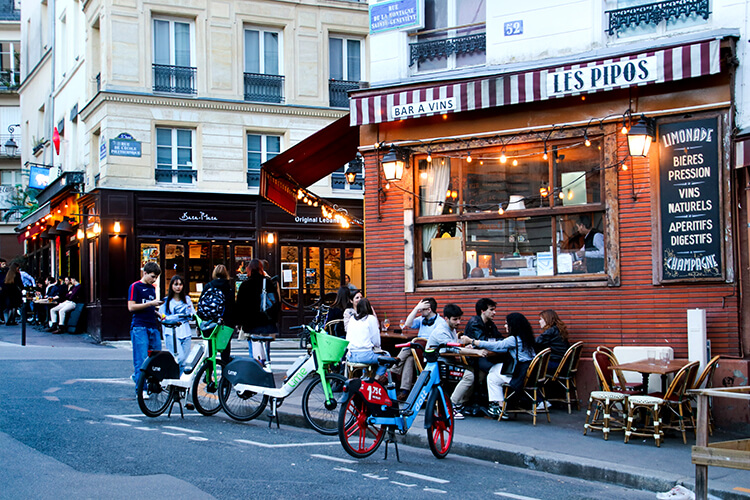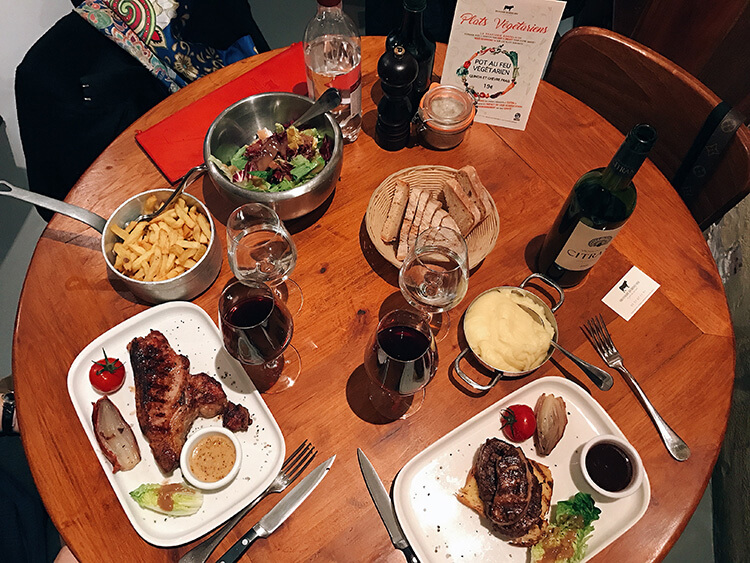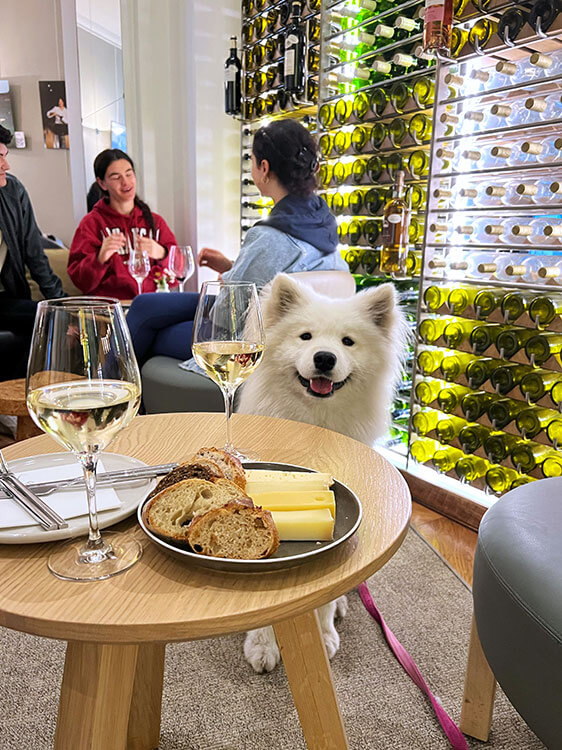Dining out has quite literally existed for thousands of years. More than 150 thermopolia, a type of establishment that served food and drink to all social classes, have been found in Pompeii. But the modern restaurant, at least as we know it today, was born in France around the time of the French Revolution.
In a country which embraces gastronomy with a passion, it should be no surprise that the French have perfected not only the art of cooking, but also the art of dining out. And while it may all seem a bit intimidating, the French are really quite practical when it comes to all the rules for dining out in France.

No matter if you’ve lived in France for years like me or whether you’re visiting France for the first time, knowing some of the most important rules when it comes to eating out can really help you feel at ease in any cafe or brasserie.
Don’t go to restaurants in France without knowing these unspoken rules that will help you fit in with the French locals.
1. Always say “Bonjour” or “Bonsoir”.
Whether it’s at a restaurant, boutique, or the pharmacy, the number one hard and fast rule is that you always greet any person you interact with. France is very formal when it comes to greeting people, and it is considered rude if you don’t acknowledge and greet people.
A simple “bonjour” will do when greeting people, and abiding by this expected exchange or not can be the deciding factor on what kind of service you’ll receive. So if there’s any rule you learn and follow when planning to visit France, it’s this one.
You can also use bonjour in the evening, but if you want to step up your French etiquette game then switch to using bonsoir (good evening) after 6pm.
2. Assume you need a reservation
It’s best to make a reservation these days for most restaurants in any major city in France, especially if you have your heart set on eating at a specific restaurant. France regularly tops the list of the world’s most visited countries, and when you combine more than 70 million annual visitors with locals who are epicureans by nature, the best restaurants fill up fast – yes, even that casual corner bistro on a weekday.
Unlike in the US, most restaurants do not offer continuous service and the tables aren’t turned over. Typically lunch service is offered from 12pm – 2:30pm and dinner service is offered from 7pm – 10pm. There is usually 1-2 seatings for each meal service, and once all the tables are taken you’ll be told that the restaurant is “complet“ (meaning full) and turned away. So unless a restaurant specifically states it does not accept reservations, assume that you need to book.
But there’s no need to stress over the thought of fuddling through a telephone conversation in French to make a reservation. Many restaurants in France these days offer convenient online reservation booking. The app The Fork is similar to OpenTable in the US, and you can search for a restaurant using a variety of filters including by city, neighborhood, type of food, and restaurant name. And if you find yourself in need a restaurant last minute, there’s even a filter for finding a table right now.
Of course, not every restaurant is conveniently available on The Fork. You can also use the Google Maps app, and many offer the ability to reserve a table right in the app. Finally, you can also check the restaurant’s website for either online booking or a contact form to make a booking request.
Even as a local in France, calling the restaurant to make a reservation is my absolute last resort. If you’re staying at a hotel, the concierge or front desk can also assist by calling the restaurant for you. But if you do find yourself calling a restaurant to make a reservation, don’t forget rule #1: always start with a bonjour!
How far in advance you need to book a reservation depends on the restaurant. The most sought after hotspots might need to be book weeks or even months in advance. For most restaurants, reserving a few days or even the day of is just fine.
3. Keep those reservations
If you do make a reservation, be sure to honor it. If you can’t make your reservation, don’t just not show up.
As I already said, most restaurants are small and only offer 1-2 seatings per meal service. When you make a reservation, the restaurant plans that your table is unavailable for the entirety of their service. Always call to cancel with as much notice as possible, so that the restaurant can potentially offer the table to other diners and not lose out on profit.

4. Order like a local
Particularly at the lunch meal, many restaurants offer a formule. For a fixed reduced price, you can choose from a smaller menu of a few set dishes to compose a meal. The formule can usually be a 3-course meal with entrée, plat and dessert; or a 2-course meal with either entrée and plat or plat and dessert. The formule can be really good value.
It may sound like a lot of food, but the biggest meal if the day is typically eaten at lunch in France. Remember, portion sizes are also much smaller than in the US.
In the US, entrée is the main dish and that can be confusing for Americans when ordering from French menus. Entrée, adopted from the French translation meaning to start, is actually the appetizer and the main course is called plat.
When it comes to ordering drinks, it is perfectly acceptable to order tap water instead of bottled water. Tap water is free and totally safe to drink in France. To order tap water, ask for une carafe d’eau.
There’s a certain order for ordering alcoholic drinks. The apéritif is meant to be drunk before the meal to get the appetite going. Champagne is not an apérirtif, as it’s meant be drunk with food. Order Champagne, wine or other liquor to drink with the meal. You might also be offered a digestif to finish off the meal after dessert, and this is something like a Cognac, Armagnac or perhaps something local to the area.
Don’t be afraid to ask your server to make a recommendation if you’re unsure what to order to drink.
When it comes to dessert, my personal favorite is café gourmand. Café gourmand is basically an espresso with 3 – 5 mini desserts and typically costs around the same as a single dessert. I love it because you typically get to sample mini versions of the desserts on the menu, and it is great value.
5. French bread etiquette
France is considered to make some of the best bread in the world. The baguette was even inscribed on the UNESCO list of intangible cultural heritage. And if you haven’t yet discovered just what a wonderfully delicious thing French bread is, then I suggest you immediately head to a boulangerie on your trip to France.
When dining out in France, you usually get a basket of bread to accompany your meal. Of course, like French restaurant etiquette itself, there are some rules about bread.
First, you’ll notice butter is not served with the bread. Unlike in the US where we usually dig in to the bread basket and slather it with some butter while waiting for our meal to arrive, French bread is not meant to tide you over until the meal arrives. Instead, it’s a utensil like a fork or spoon meant to sop up the delicious sauces. Bread can also be eaten after the meal with the cheese course.
Second, you might notice the bread plate is missing. Unless you’re at a very high-end restaurant like a Michelin-star restaurant, the bread is meant to be placed directly on the table next to your plate.
Third, if you need more bread, don’t be afraid to ask. It’s included with most main dishes, or plats, by French law.
6. The service
One of the biggest differences between dining out in France and dining out in the US is the service. In fact, the cultural differences of eating out are so different in these two countries it’s not even comparing apples to oranges. It’s more like comparing apples to oysters, and it can lead to some big misconceptions – mainly that French waiters are rude and ignore you.
Understand that in France, the meal is a leisurely affair meant to be enjoyed among family and friends. While it can feel like your waiter is ignoring you, they actually don’t want to waste your time with small talk or interrupt you enjoying your meal. If you need something, you’re meant to signal to your server over.
Speaking of, your server is not garçon. Garçon means boy, and it’s rude to call a male server such. You can call your male server monsieur and your female server mademoiselle. A simple pardon or excusez-moi will also do. Or if you can make eye contact with your server, you can slightly raise your hand up to signal you need them.
Once you’ve finished eating, place your form and knife diagonally together on your plate. This signals your server you are ready for the plates to be cleared.
7. Paying the bill
In France it’s considered rude to bring the bill before the customer has specifically requested it. Unless there is a second dinner service, you’re allowed to linger as long as you like unlike closing time.
So don’t just sit and wait for the bill in annoyance. If you’re ready to pay and leave, say “l’addition s’il vous plaît”. But once you do receive your bill, pay it promptly and leave. If you’re paying with a card or something like Apple Pay, the server will bring the card machine directly to your table.
Don’t worry if your waiter seems busy and you really need to be on your way. It’s not uncommon to pop inside to the bar or cashier to pay your bill in just about any casual restaurant.
Splitting the bill is also not the big to do that restaurants in the US tend to make it out to be. Splitting the bill is done regularly by locals and tourists alike in France. Of course, splitting the bill evenly is easiest for everyone, but it is also perfectly acceptable to pay for what each person had if you prefer.
The price of the meal in France includes all service charges already, so tips aren’t required. Tips are appreciated though, and if you do want to tip leave a few Euro coins on the table. Most French people who tip leave 5%, or perhaps 10% for very good service. There’s no tip line on a French credit card slip, so always have cash on hand if you do want to tip.

8. Dining out with dogs in France
Well behaved dogs are generally treated like royalty in France, and usually served a bowl of water before your server even asks what you’d like to drink.
There’s no law in France that prohibits dogs from being in restaurants, so it’s left to each restaurant’s discretion. About 90% of restaurants in France allow you to dine with your dog both outside on the terrace and indoors. If a restaurant is not dog-friendly, they must display a no dogs allowed sign or a sign saying “chiens interdits”.
It’s always polite to include a note with your reservation that you’ll be dining with a dog or to ask if you’re walking-up for a table. Always keep your dog on a leash, off the furniture and out of the way of servers and other patrons. It’s expected dogs shouldn’t disturb other customers.